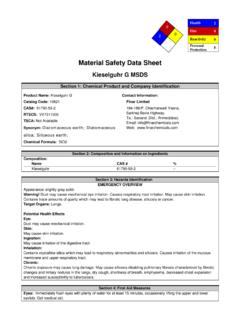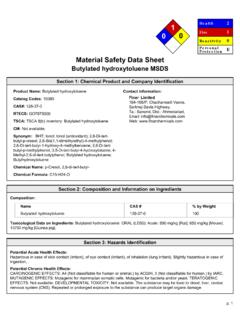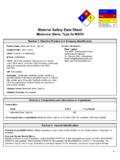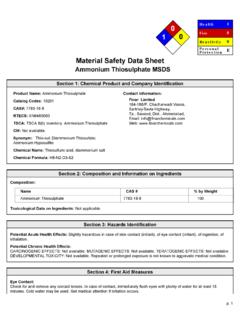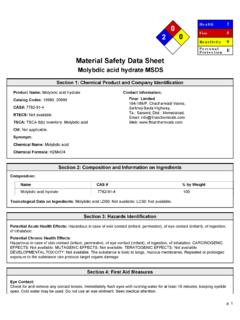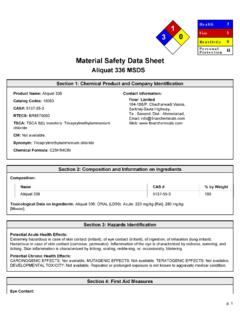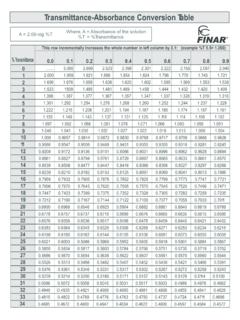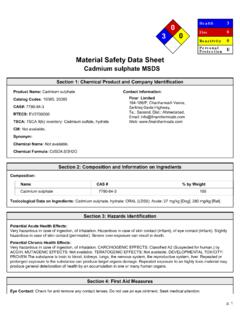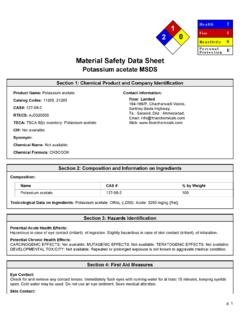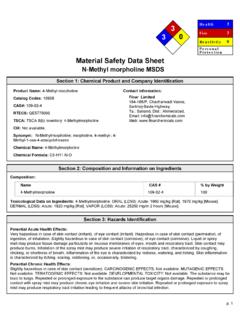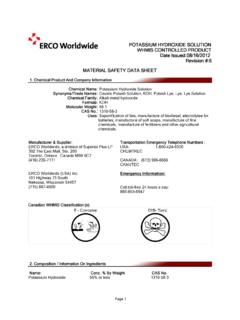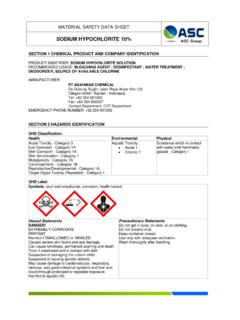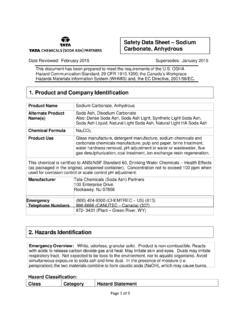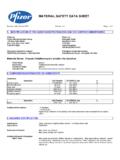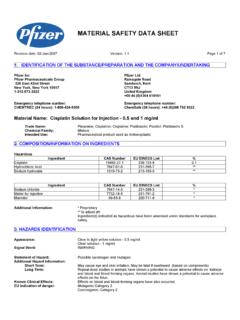Transcription of Material Safety Data Sheet - Finar Chemicals Ltd.
1 P. 1 0 4 2He a lt hFireRe a c t iv it yP e rs o n a lP ro t e c t io n302 Material Safety Data SheetThionyl chloride MSDSS ection 1: Chemical Product and Company IdentificationProduct Name: thionyl chlorideCatalog Codes: 11843 CAS#: 7719-09-7 RTECS: XM5150000 TSCA: TSCA 8(b) inventory: thionyl chlorideCI#: Not : Sulfurous oxychloride; Sulfinyl chloride ; Sulfurchloride oxide; Sulfurous dichloride; thionyl dichlorideChemical Name: thionyl chlorideChemical Formula: Cl2 OSContact Information: Finar Limited 184-186/P, Chacharwadi Vasna, Sarkhej-Bavla Highway, Ta.
2 : Sanand, Dist.: Ahmedabad, Email: Web: 2: Composition and Information on IngredientsComposition:NameCAS #% by WeightThionyl chloride7719-09-7100 Toxicological Data on Ingredients: thionyl chloride : VAPOR (LC50): Acute: 500 ppm 1 hours [Rat].Section 3: Hazards IdentificationPotential Acute Health Effects:Very hazardous in case of skin contact (irritant), of eye contact (irritant), of ingestion, of inhalation. Hazardous in case ofskin contact (corrosive, permeator), of eye contact (corrosive). Liquid or spray mist may produce tissue damage particularlyon mucous membranes of eyes, mouth and respiratory tract.
3 Skin contact may produce burns. Inhalation of the spray mistmay produce severe irritation of respiratory tract, characterized by coughing, choking, or shortness of breath. Severe over-exposure can result in death. Inflammation of the eye is characterized by redness, watering, and itching. Skin inflammation ischaracterized by itching, scaling, reddening, or, occasionally, Chronic Health Effects:CARCINOGENIC EFFECTS: Not available. MUTAGENIC EFFECTS: Not available. TERATOGENIC EFFECTS: Not TOXICITY: Not available. The substance may be toxic to upper respiratory tract, skin, eyes.
4 Repeatedor prolonged exposure to the substance can produce target organs damage. Repeated or prolonged contact with spray mistmay produce chronic eye irritation and severe skin irritation. Repeated or prolonged exposure to spray mist may producerespiratory tract irritation leading to frequent attacks of bronchial infection. Repeated exposure to a highly toxic Material mayproduce general deterioration of health by an accumulation in one or many human 2 Section 4: First Aid MeasuresEye Contact:Check for and remove any contact lenses. In case of contact, immediately flush eyes with plenty of water for at least 15minutes.
5 Get medical attention Contact:In case of contact, immediately flush skin with plenty of water for at least 15 minutes while removing contaminated clothingand shoes. Cover the irritated skin with an emollient. Wash clothing before reuse. Thoroughly clean shoes before reuse. Getmedical attention Skin Contact:Wash with a disinfectant soap and cover the contaminated skin with an anti-bacterial cream. Seek immediate :If inhaled, remove to fresh air. If not breathing, give artificial respiration. If breathing is difficult, give oxygen. Get medicalattention Inhalation:Evacuate the victim to a safe area as soon as possible.
6 Loosen tight clothing such as a collar, tie, belt or waistband. Ifbreathing is difficult, administer oxygen. If the victim is not breathing, perform mouth-to-mouth resuscitation. WARNING: It maybe hazardous to the person providing aid to give mouth-to-mouth resuscitation when the inhaled Material is toxic, infectious orcorrosive. Seek immediate medical :Do NOT induce vomiting unless directed to do so by medical personnel. Never give anything by mouth to an unconsciousperson. If large quantities of this Material are swallowed, call a physician immediately. Loosen tight clothing such as a collar,tie, belt or Ingestion: Not 5: Fire and Explosion DataFlammability of the Product: Temperature: Not Points: Not Limits: Not of Combustion: Not Hazards in Presence of Various Substances: Not Hazards in Presence of Various Substances:Risks of explosion of the product in presence of mechanical impact: Not available.
7 Risks of explosion of the product inpresence of static discharge: Not Fighting Media and Instructions: Not Remarks on Fire Hazards: When heated to decomposition it emits toxic Remarks on Explosion Hazards:I t w i l l e x p l o d e i n t h e p r e s e n c e o f s e v e r a l c h e m i c a l s : A z i d o a c e t y l a c i d , C h l o r y l p e r c h lo r a t e , N,N-Dimethylformamide, Dimethyl sulfoxide and acyl halides, Hexafluoropropyplideneaminolithium, Linseed oil +quinoline, o-Nitrobenzoylacetic acid, p-Nitrobenzoyl and cold ammonia solution, o-Nitrophenylacetic acid; Sodium hydroxide,Sulfur dioxide, Toluene + ethanol+ water, 6: Accidental Release Measuresp.
8 3 Small Spill: Absorb with an inert Material and put the spilled Material in an appropriate waste Spill:Corrosive liquid. Poisonous liquid. Stop leak if without risk. Absorb with DRY earth, sand or other non-combustible not get water inside container. Do not touch spilled Material . Use water spray curtain to divert vapor drift. Use water sprayto reduce vapors. Prevent entry into sewers, basements or confined areas; dike if needed. Call for assistance on disposal. Becareful that the product is not present at a concentration level above TLV. Check TLV on the MSDS and with local 7: Handling and StoragePrecautions:Keep container dry.
9 Keep away from heat. Keep away from sources of ignition. Keep away from direct sunlight or strongincandescent light. Do not ingest. Do not breathe gas/fumes/ vapor/spray. Never add water to this product. Avoid shock andfriction. In case of insufficient ventilation, wear suitable respiratory equipment. If ingested, seek medical advice immediatelyand show the container or the label. Avoid contact with skin and eyes. Keep away from incompatibles such as metals, acids,alkalis, : Keep container tightly closed. Keep container in a cool, well-ventilated 8: Exposure Controls/Personal ProtectionEngineering Controls:Provide exhaust ventilation or other engineering controls to keep the airborne concentrations of vapors below their respectivethreshold limit value.
10 Ensure that eyewash stations and Safety showers are proximal to the work-station Protection:Face shield. Full suit. Vapor respirator. Be sure to use an approved/certified respirator or equivalent. Gloves. Protection in Case of a Large Spill:Splash goggles. Full suit. Vapor respirator. Boots. Gloves. A self contained breathing apparatus should be used to avoidinhalation of the product. Suggested protective clothing might not be sufficient; consult a specialist BEFORE handling Limits:CEIL: 1 (ppm) from OSHA (PEL) [United States] CEIL: 1 from ACGIH (TLV) [United States] CEIL: 1 (ppm) from NIOSH [UnitedStates] TWA: 1 (ppm) [Denmark] STEL: 1 (ppm) [Belgium] STEL: 1 (ppm) [United Kingdom (UK)] Consult local authorities foracceptable exposure 9: Physical and Chemical PropertiesPhysical state and appearance: Liquid.
